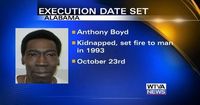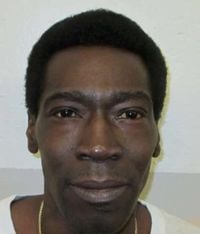On August 19, 2025, Alabama Governor Kay Ivey announced that the state would move forward with the execution of Anthony Todd Boyd, a man whose name has become synonymous with one of Anniston's most infamous crimes. The scheduled execution, set to occur between midnight on October 23 and 6:00 a.m. on October 24, 2025, will employ nitrogen hypoxia—a relatively new and controversial method of capital punishment in the United States.
Boyd, now 55, was one of four men convicted in the brutal 1993 kidnapping and murder of Gregory Huguley. According to court records cited by WEIS Radio, Huguley was abducted at gunpoint on July 31, 1993, after reportedly owing the group $200 for drugs. The men forced Huguley into a van and drove him to the Munford area of Talladega County. There, in a scene that shocked even seasoned investigators, they taped him to a park bench at a baseball field and set him on fire. Huguley’s body was discovered the following morning, a crime that has haunted the Anniston community for more than three decades.
Boyd’s journey through the legal system has been long and fraught with controversy. He has spent the past 30 years on Alabama’s death row, maintaining his innocence at trial and, in recent years, challenging the methods by which the state intends to carry out his sentence. In 2017, Boyd requested to be executed by hanging or firing squad, rather than by lethal injection, which was then Alabama’s standard method. He argued that lethal injection would violate his constitutional rights, but a federal appeals court rejected his claim. Now, with the state’s adoption of nitrogen hypoxia as an alternative execution method, Boyd faces a new—and hotly debated—protocol.
Alabama first used nitrogen hypoxia in 2024, and since then, the state has carried out five executions using the method, with another planned for September 2025. Louisiana has also used nitrogen gas for one execution. The method involves replacing breathable air with pure nitrogen gas through a mask, causing death by lack of oxygen. State officials, including those from the Alabama attorney general’s office, have argued that nitrogen hypoxia is a painless way to die. According to their court filings, any movements observed during previous executions were “either inmates actively resisting or involuntary movements associated with dying.”
Boyd himself selected nitrogen as his preferred execution method back in 2018, before Alabama had fully developed procedures for its use. But after witnessing the state’s early attempts at nitrogen executions, Boyd’s legal team filed a federal lawsuit in July 2025 seeking to prevent his execution by this method. They cited disturbing accounts from prior executions, in which inmates allegedly shook on the gurney and showed signs of conscious suffocation, terror, and pain. “Each prisoner previously executed by the State’s Protocol showed signs of conscious suffocation, terror, and pain,” Boyd’s lawyers wrote in their lawsuit, as reported by the Associated Press.
The Rev. Jeff Hood, a spiritual adviser who witnessed Alabama’s first nitrogen execution and is now working with Boyd, described the scene in harrowing terms. “I was horrified by what I saw at that execution, which I would describe as being suffocated to death,” Hood said, according to AP. These accounts have fueled a broader debate about whether nitrogen hypoxia truly represents a more humane alternative to lethal injection or simply introduces a new set of ethical and constitutional concerns.
Despite the ongoing lawsuit, Governor Ivey formalized the execution time frame in a letter to Alabama Department of Corrections Commissioner John Hamm, supported by an order from the Alabama Supreme Court. The window for Boyd’s execution, beginning at midnight and concluding no later than 6:00 a.m. the following morning, is designed to accommodate any last-minute legal challenges or procedural issues that might arise.
Boyd’s case is further complicated by his role as chairman of Project Hope to Abolish the Death Penalty, an anti-death penalty group founded by men on Alabama’s death row. Over the years, Boyd has become a vocal opponent of capital punishment, using his position to draw attention to what he and others see as systemic flaws in the state’s approach to the death penalty. His legal team has not only challenged the method of his execution but also pointed to broader issues of fairness and due process in his original trial.
At his trial, Boyd’s lawyers maintained that he was at a party the night of Huguley’s murder and did not participate in the crime. Nevertheless, a jury convicted him of capital murder during a kidnapping and recommended by a vote of 10-2 that he receive a death sentence. The other men involved in the case received varying sentences: Shawn Ingram, accused of pouring the gasoline and setting Huguley on fire, was also convicted of capital murder and remains on death row; Moneek Ackles was sentenced to life in prison without parole; and Quintay Cox, who pleaded guilty to a lesser charge of murder as part of a plea deal, was sentenced to life with the possibility of parole.
The crime itself remains one of the most notorious in Anniston’s history. As WVTM 13 and other local outlets have reported, the details of Huguley’s abduction, torture, and murder have lingered in the public consciousness, shaping community attitudes about crime, punishment, and justice. For some, the scheduled execution of Boyd represents a long-overdue measure of closure. For others, it is a troubling reminder of the complexities and moral ambiguities inherent in capital punishment.
The federal judge overseeing Boyd’s lawsuit has scheduled a hearing for September 4, 2025, to consider whether the execution should proceed as planned. The outcome of that hearing could have significant implications not only for Boyd but also for the future of nitrogen hypoxia as an execution method in Alabama and beyond.
As the execution date approaches, both supporters and opponents of the death penalty are watching closely. Death penalty opponents, including organizations like Project Hope to Abolish the Death Penalty, have renewed their calls for Alabama to halt Boyd’s execution and reconsider the use of nitrogen gas. Meanwhile, state officials maintain that all legal requirements have been met and that the execution should move forward.
With just weeks to go before the scheduled execution, the case of Anthony Todd Boyd continues to raise difficult questions about justice, mercy, and the evolving standards of decency in American society. The final chapter in this decades-old saga has yet to be written, but its impact will be felt in Alabama—and beyond—for years to come.





